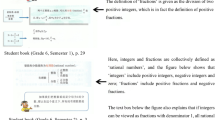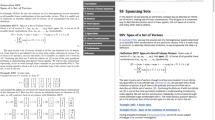Abstract
This paper presents a qualitative study on how students make use of their mathematics textbooks for practicing. The study was carried out in two German secondary schools with 74 students (44 in 6th and 30 in 12th grade). Students’ utilization of textbooks for practicing is analyzed using the theoretical framework of instrumental genesis. The results indicate that students’ choices of contents from the book for practicing can be categorized into three utilization schemes: position-dependent practicing, block-dependent practicing, and salience-dependent practicing. In terms of position-dependent practicing the relative position of the textbook’s contents to teacher-mediated sections guides the students’ choice. Block-dependent practicing relates to the use of contents from the book that belong to particular blocks. Finally, salience-dependent practicing is a utilization scheme of the book where students’ choice is guided by perceptual salience of the book contents. These findings both show how textbook users are influenced by the way mathematics is presented in textbooks and provide insights into students’ conceptions of practicing mathematics.







Similar content being viewed by others
Notes
The notion of “kernels” refers to van Dormolen (1986) and denotes “general expressions that have to be learned as knowledge” (p. 146).
In Germany, schools usually provide textbooks. Therefore, writing or highlighting in textbooks is not allowed.
The larger number of observed lessons in grade 12 results from one course being an advanced course with twice as many lessons a week as the normal courses.
References
Artigue, M. (2002). Learning mathematics in a CAS environment: The genesis of a reflection about instrumentation and the dialectics between technical and conceptual work. International Journal of Computers for Mathematical Learning, 7(3), 245–274.
Baum, M., Lind, D., Schermuly, H., Weidig, I., & Zimmermann, P. (2001). Lambacher Schweizer. Lineare Algebra mit Analytischer Geometrie. Leistungskurs. Stuttgart: Ernst Klett.
Brantlinger, A. (2011). Rethinking critical mathematics: A comparative analysis of critical, reform, and traditional geometry instructional texts. Educational Studies in Mathematics, 78(3), 395–411.
Bryant, B., Bryant, D., Kethley, C., Kim, S., Pool, C., & Sin, Y. (2008). Preventing mathematics difficulties in the primary grades: The critical features of instruction in textbooks as part of the equation. Learning Disability Quarterly, 31(1), 21–35.
Collopy, R. (2003). Curriculum materials as a professional development tool: How a mathematics textbook affected two teachers’ learning. Elementary School Journal, 103(3), 287–311.
Cronbach, L. J. (1955). The text in use. In L. J. Cronbach (Ed.), Text materials in modern education: A comprehensive theory and platform for research (pp. 188–216). Urbana: University of Illinois Press.
Davis, J. (2009). Understanding the influence of two mathematics textbooks on prospective secondary teachers’ knowledge. Journal of Mathematics Teacher Education, 12(5), 365–389. doi:10.1007/s10857-009-9115-2.
van Dormolen, J. (1986). Textual analysis. In B. Christiansen, A. G. Howson, & M. Otte (Eds.), Perspectives on mathematics education (pp. 141–171). Dordrecht: Reidel.
Engeström, Y. (1987). Learning by expanding: An activity-theoretical approach to developmental research. Helsinki: Orienta-Konsultit Oy.
Engeström, Y., Miettinen, R., & Punamäki, R.-L. (Eds.). (1999). Perspectives on activity theory. New York: Cambridge University Press.
Fan, L. (2011). Textbook research as scientific research: towards a common ground for research on mathematics textbooks. Paper presented at the 2011 International Conference on School Mathematics Textbooks, Shanghai, PRC, 12–14 Oct 2011. http://eprints.soton.ac.uk/201715. Accessed 25 July 2013.
Hußmann, S., Jörgens, T., Jürgensen, T., Leuders, T., Richter, K., Riemer, W., et al. (2006). Lambacher Schweizer 6. Mathematik für Gymnasien. Nordrhein-Westfalen. Stuttgart: Ernst Klett.
Johansson, M. (2006). Textbooks as instruments. Three teachers’ ways to organize their mathematics lessons. NOMAD, 11(3), 5–30.
Kluge, S. (2000). Empirically grounded construction of types and typologies in qualitative social research. Forum Qualitative Sozialforschung/Forum: Qualitative Social Research, 1(1), Art. 14.
Lithner, J. (2003). Students’ mathematical reasoning in university textbook exercises. Educational Studies in Mathematics, 52(1), 29–55.
Love, E., & Pimm, D. (1996). ‘This is so’: A text on texts. In A. J. Bishop, K. Clements, C. Keitel, J. Kilpatrick, & C. Laborde (Eds.), International Handbook of Mathematics Education (pp. 371–409). Dordrecht: Kluwer.
Mauch, E. M., M. (2007). Can elementary mathematics textbooks be improved to facilitate student understanding of mathematics? Mathematics and Computer Education, 41(2), 127–135.
Nicholls, J. (2003). Methods in school textbook research. International Journal of Historical Learning, Teaching and Research, 3(2), 1–17.
Nicol, C. C., & Crespo, S. M. (2006). Learning to teach with mathematics textbooks: How preservice teachers interpret and use curriculum materials. Educational Studies in Mathematics, 62(3), 331–355.
Pepin, B., & Haggarty, L. (2001). Mathematics textbooks and their use in English, French and German classrooms: A way to understand teaching and learning cultures. Zentralblatt für Didaktik der Mathematik, 33(5), 158–175.
Rabardel, P. (1995). Les hommes et les technologies: Une approche cognitive des instruments contemporains. http://ergoserv.psy.univ-paris8.fr/Site/default.asp?Act_group=1. Accessed 25 July 2013.
Rabardel, P. (2002). People and technology: A cognitive approach to contemporary instruments. http://ergoserv.psy.univ-paris8.fr/Site/default.asp?Act_group=1. Accessed 25 July 2013.
Remillard, J. T. (2005). Examining key concepts in research on teachers’ use of mathematics curricula. Review of Educational Research, 75(2), 211–246.
Rezat, S. (2006). The structure of German mathematics textbooks. Zentralblatt für Didaktik der Mathematik, 38(6), 482–487.
Rezat, S. (2008). Die Struktur von Mathematikschulbüchern. Journal für Mathematik-Didaktik, 29(1), 46–67.
Rezat, S. (2011). Wozu verwenden Schüler ihre Mathematikschulbücher? Ein Vergleich von erwarteter und tatsächlicher Nutzung. Journal für Mathematik-Didaktik, 32(2), 153–177. doi:10.1007/s13138-011-0028-0.
Rezat, S., & Sträßer, R. (2012). From the didactical triangle to the socio-didactical tetrahedron: artifacts as fundamental constituents of the didactical situation. ZDM—The International Journal on Mathematics Education, 44(5), 641–651. doi:10.1007/s11858-012-0448-4.
Strauss, A., & Corbin, J. (1990). Basics of qualitative research: Grounded theory procedures and techniques. Newbury Park: Sage.
Törnroos, J. (2005). Mathematics textbooks, opportunity to learn and student achievement. Studies in Educational Evaluation, 31(4), 315–327.
Valverde, G. A., Bianchi, L. J., Wolfe, R. G., Schmidt, W. H., & Houang, R. T. (2002). According to the book—using TIMSS to investigate the translation of policy into practice through the world of textbooks. Dordrecht: Kluwer.
Vergnaud, G. (1988). Multiplicative structures. In J. Hiebert & M. Behr (Eds.), Number concepts and operations in the middle grades (pp. 141–161). Hillsdale: Erlbaum.
Vergnaud, G. (1996). The theory of conceptual fields. In L. P. Steffe, P. Nesher, C. Paul, G. A. Goldin, & B. Greer (Eds.), Theories of mathematical learning (pp. 219–239). Mahwah: Lawrence Erlbaum.
Vergnaud, G. (1998). A comprehensive theory of representation for mathematics education. Journal of Mathematical Behaviour, 17(2), 167–181.
Vygotsky, L. (1997). The instrumental method in psychology. In R. W. Rieber & J. Wollock (Eds.), The collected works of L. S. Vygotsky. Problems of the theory and history of psychology (Vol. 3, pp. 85–89). New York: Plenum Press.
Weinberg, A., & Wiesner, E. (2011). Understanding mathematics textbooks through reader-oriented theory. Educational Studies in Mathematics, 76(1), 49–63. doi:10.1007/s10649-010-9264-3.
Author information
Authors and Affiliations
Corresponding author
Rights and permissions
About this article
Cite this article
Rezat, S. The textbook-in-use: students’ utilization schemes of mathematics textbooks related to self-regulated practicing. ZDM Mathematics Education 45, 659–670 (2013). https://doi.org/10.1007/s11858-013-0529-z
Accepted:
Published:
Issue Date:
DOI: https://doi.org/10.1007/s11858-013-0529-z




